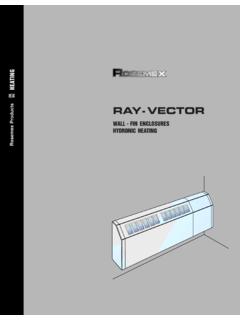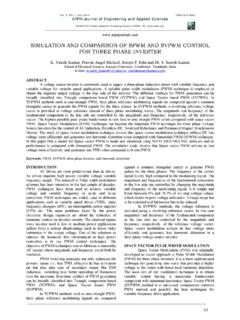Transcription of Sparse Vector Autoregressive Modeling - arXiv
1 Sparse Vector Autoregressive ModelingRichard A. Davis, Pengfei Zang, Tian ZhengDepartment of statistics, Columbia UniversityJuly 1, 2012 AbstractThe Vector Autoregressive (VAR) model has been widely used for Modeling temporal de-pendence in a multivariate time series. For large (and even moderate) dimensions, the numberof AR coefficients can be prohibitively large, resulting in noisy estimates, unstable predictionsand difficult-to-interpret temporal dependence. To overcome such drawbacks, we propose a2-stage approach for fitting Sparse VAR (sVAR) models in which many of the AR coefficientsare zero. The first stage selects non-zero AR coefficients based on an estimate of the partialspectral coherence (PSC) together with the use of BIC. The PSC is useful for quantifying theconditional relationship between marginal series in a multivariate process. A refinement secondstage is then applied to further reduce the number of parameters. The performance of this2-stage approach is illustrated with simulation results.
2 The 2-stage approach is also applied totwo real data examples: the first is the Google Flu Trends data and the second is a time seriesof concentration levels of air : Vector Autoregressive (VAR) model, sparsity, partial spectral coherence (PSC),model IntroductionThe Vector Autoregressive (VAR) model has been widely used for Modeling the temporal depen-dence structure of a multivariate time series. Unlike univariate time series, the temporal dependenceof a multivariate series consists of not only the serial dependence within each marginal series, butalso the interdependence across different marginal series. The VAR model is well suited to describesuch temporal dependence structures. However, the conventional VAR model can be saturatedly-parametrized with the number of AR coefficients prohibitively large for high (and even moderate)dimensional processes. This can result in noisy parameter estimates, unstable predictions anddifficult-to-interpret descriptions of the temporal overcome these drawbacks, we propose a 2-stage approach for fitting Sparse VAR (sVAR)models in which many of the autoregression (AR) coefficients are zero.
3 Such sVAR models canenjoy improved efficiency of parameter estimates, better prediction accuracy and more interpretabledescriptions of the temporal dependence structure. In the literature, a class of popular methods for1 [ ] 2 Jul 2012fitting sVAR models is to re-formulate the VAR model as a penalized regression problem, wherethe determination of which AR coefficients are zero is equivalent to a variable selection problemin a linear regression setting. One of the most commonly used penalties for the AR coefficients inthis context is the Lasso penalty proposed by Tibshirani (1996) and its variants tailored for theVAR Modeling purpose, , see Vald es-Sosa et al. (2005); Hsu et al. (2008); Arnold et al. (2008);Lozano et al. (2009); Haufe et al. (2010); Shojaie and Michailidis (2010); Song and Bickel (2011).The Lasso-VAR Modeling approach has the advantage of performing model selection and parameterestimation simultaneously. It can also be applied under the large-p-small-n setting.
4 However,there are also disadvantages in using this approach. First, Lasso has a tendency to over-select theorder of the autoregression model and this phenomenon has been reported in various numericalresults, , see Arnold et al. (2008); Lozano et al. (2009); Shojaie and Michailidis (2010). Second,in applying the Lasso-VAR approach, the VAR model is re-formulated as a linear regression model,where current values of the time series are treated as the response variable and lagged values aretreated as the explanatory variables. Such a treatment ignores the temporal dependence in thetime series. Song and Bickel (2011) give a theoretical discussion on the consequences of applyingLasso directly to the VAR model without taking into account the temporal dependence betweenthe response and the explanatory this paper, we develop a 2-stage approach of fitting sVAR models. The first stage selects non-zero AR coefficients by screening pairs of distinct marginal series that are conditionally compute the conditional correlation between component series, an estimate of thepartial spectralcoherence(PSC) is used in the first stage.
5 PSC is a tool in frequency-domain time series analysisthat can be used to quantify direction-free conditional dependence between component series of amultivariate time series. An efficient way of computing a non-parametric estimate of PSC is basedon results of Brillinger (1981) and Dahlhaus (2000). In conjunction with the PSC, theBayesianinformation criterion(BIC) is used in the first stage to determine the number of non-zero off-diagonal pairs of AR coefficients. The VAR model fitted in stage 1 may contain spurious non-zerocoefficients. To further refine the fitted model, we propose, in stage 2, a screening strategy basedon thet-ratios of the coefficient estimates as well as remainder of this paper is organized as follows. In Section 2, we review some results on theVAR model for multivariate time series. In Section 3, we describe a 2-stage procedure for fitting asparse VAR model. Connections between our first stage selection procedure with Granger causalmodels are give in Section In Section , simulation results are presented to compare theperformance of the 2-stage approach against the Lasso-VAR approach.
6 In Section the 2-stageapproach is applied to fit sVAR models to two real data examples: the first is the Google FluTrends data (Ginsberg et al. (2009)) and the second is a time series of concentration levels of airpollutants (Songsiri et al. (2010)). Further discussion is contained in Section 5. Supplementarymaterial is given in the Sparse Vector Autoregressive Vector Autoregressive models (VAR)Suppose{Yt}={(Yt,1,Yt,2,..,Yt,K) }is a Vector Autoregressive process of orderp(VAR(p)),which satisfies the recursions,Yt= +p k=1 AkYt k+Zt, t= 0, 1,..,( )whereA1,..,Apare real-valuedK Kmatrices of autoregression (AR) coefficients;{Zt}areK-dimensional iid Gaussian noise with mean0and non-degenerate covariance matrix assume that the process{Yt}iscausal, , det(IK p k=1 Akzk)6= 0, forz C,|z|<1, ,see Brockwell and Davis (1991) and Reinsel (1997), which implies thatZtis independent ofYsfors < t. Without loss of generality, we also assume that the Vector process{Yt}has mean0, , =0in ( ).
7 Sparse Vector Autoregressive models (sVAR)The temporal dependence structure of the VAR model ( ) is characterized by the AR coeffi-cient matricesA1,..,Ap. Based onTobservationsY1,..,YTfrom the VAR model, we want toestimate these AR matrices. However, a VAR(p) model, when fully-parametrized, hasK2pARparameters that need to be estimated. For large (and even moderate) dimensionK, the numberof parameters can be prohibitively large, resulting in noisy estimates, unstable predictions anddifficult-to-interpret descriptions of the temporal dependence. It is also generally believed that, formost applications, the true model of the series is Sparse , , the number of non-zero coefficientsis small. Therefore it is preferable to fit asparseVAR (sVAR) model in which many of its ARparameters are zero. In this paper we develop a 2-stage approach of fitting sVAR models. Thefirst stage selects non-zero AR coefficients by screening pairs of distinct marginal series that areconditionally correlated.
8 To compute direction-free conditional correlation between components inthe time series, we use tools from the frequency-domain, specifically thepartial spectral coherence(PSC). Below we introduce the basic properties related to {Yt,i}and{Yt,j}(i6=j) denote two distinct marginal series of the process{Yt}, and{Yt, ij}denote the remaining (K 2)-dimensional process. To compute the conditional correlationbetween two time series{Yt,i}and{Yt,j}, we need to adjust for the linear effect from the remainingmarginal series{Yt, ij}. The removal of the linear effect of{Yt, ij}from each of{Yt,i}and{Yt,j}can be achieved by using results of linear filters, , see Brillinger (1981) and Dahlhaus (2000).Specifically, the optimal linear filter for removing the linear effect of{Yt, ij}from{Yt,i}is givenby the set of (K 2)-dimensional constant vectors that minimizes the expected squared error of1In this paper we assume that the VAR(p) process{Yt}is Gaussian. When{Yt}is non-Gaussian, the 2-stagemodel fitting approach can still be applied, where now the Gaussian likelihood is interpreted as a ,{Doptk,i RK 2,k Z}= argmin{Dk,i,k Z}E(Yt,i k= Dk,iYt k, ij)2.
9 ( )Theresidual seriesfrom the optimal linear filter is defined as, t,i:=Yt,i k= Doptk,iYt k, , we use{Doptk,j RK 2,k Z}and{ t,j}to denote the optimal linear filter and thecorresponding residual series for another marginal series{Yt,j}. Then the conditional correlationbetween{Yt,i}and{Yt,j}is characterized by the correlation between the two residual series{ t,i}and{ t,j}. In particular, two distinct marginal series{Yt,i}and{Yt,j}areconditional ly uncorrelatedafter removing the linear effect of{Yt, ij}if and only if their residual series{ t,i}and{ t,j}areuncorrelated at all lags, , cor( t+k,i, t,j) = 0, fork Z. In the frequency domain,{ t,i}and{ t,j}are uncorrelated at all lags is equivalent to the cross-spectral density of the two residualseries, denoted byf ij( ), is zero at all frequencies . Here the residual cross-spectral density isdefined by,f ij( ):=12 k= ij(k)e ik , ( , ],( )where ij(k):= cov( t+k,i, t,j). The cross-spectral densityf ij( ) reflects the conditional (or partial)correlation between the two corresponding marginal series{Yt,i}and{Yt,j}, given{Yt, ij}.)
10 Thisobservation leads to the definition ofpartial spectral coherence(PSC), , see Brillinger (1981);Brockwell and Davis (1991), between two distinct marginal series{Yt,i}and{Yt,j}, which is definedas the scaled cross-spectral density between the two residual series{ t,i}and{ t,j}, ,PSCij( ):=f ij( ) f ii( )f jj( ), ( , ].( )Brillinger (1981) showed that the cross-spectral densityf ij( ) can be computed from the spectraldensityfY( ) of the process{Yt}via,f ij( ) =fYii( ) fYi, ij( )fY ij, ij( ) 1fY ij,j( ),( )which involves inverting a (K 2) (K 2) dimensional matrix, ,fY ij, ij( ) 1. Using ( )to compute the PSCs for all pairs of distinct marginal series of{Yt}requires(K2)such matrixinversions, which can be computationally challenging for a large dimensionK. Dahlhaus (2000)proposed a more efficient method to simultaneously compute the PSCs for all(K2)pairs throughthe inverse of the spectral density matrix, which is defined asgY( ):=fY( ) 1: LetgYii( ),gYjj( )andgYij( ) denote theith diagonal, thejth diagonal and the (i,j)th entry ofgY( ), respectively;4 Then the partial spectral coherence between{Yt,i}and{Yt,j}can be computed as follows,PSCij( ) = gYij( ) gYii( )gYjj( ), ( , ].))
![arXiv:0706.3639v1 [cs.AI] 25 Jun 2007](/cache/preview/4/1/3/9/3/1/4/b/thumb-4139314b93ef86b7b4c2d05ebcc88e46.jpg)

![arXiv:1301.3781v3 [cs.CL] 7 Sep 2013](/cache/preview/4/d/5/0/4/3/4/0/thumb-4d504340120163c0bdf3f4678d8d217f.jpg)
![@google.com arXiv:1609.03499v2 [cs.SD] 19 Sep 2016](/cache/preview/c/3/4/9/4/6/9/b/thumb-c349469b499107d21e221f2ac908f8b2.jpg)













